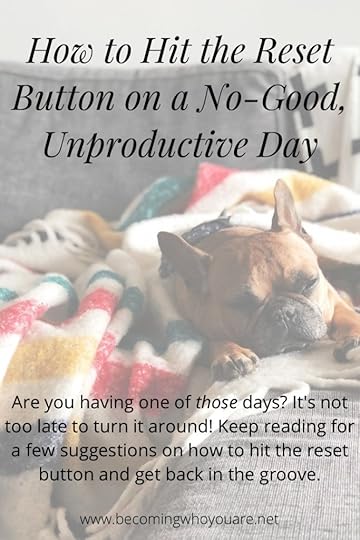Hannah Braime's Blog, page 2
June 10, 2019
The 7 Characteristics of the Fully-Functioning Person
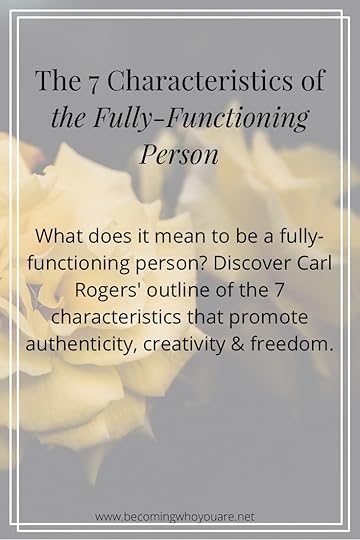
One of my biggest influences in the realm of personal growth has been the work of Carl Rogers, the creator of person-centred therapy. I came across his work through the Psychology Book Club and explored it further while doing a year’s person-centred counselling training several years ago.
There are many things I appreciate about his approach to and perspectives on personal growth (especially compared to some of the other prominent figures in the psychology world), but the number one thing that draws me to his approach is his humanity and compassion. He is deeply respectful of our uniqueness, focuses on potential rather than pathology and leaves a lot of room within his ideas and frameworks for people to be individuals and live the ideas in accordance with who they are.
One of these frameworks, and the one I want to share this week, is the seven characteristics of the fully-functioning person, which he writes about in his excellent book On Becoming a Person. These characteristics aren’t a state of being we arrive at, but rather a constant process we are working towards (Rogers calls this “the good life”—an apt description!). As you’ll see, these characteristics are more rooted in philosophy than practical life advice and many of them are connected. Together, they are all about fulfilling our human potential and provide a useful overview of things to pay attention to as we reflect on our daily experiences.
The 7 Characteristics1. A growing openness to experienceHaving a growing openness to experience is about moving away from defensiveness. John Gottman describes defensiveness as: “self-protection in the form of righteous indignation or innocent victimhood in an attempt to ward off a perceived attack.” When we perceive ourselves to be under emotional attack or criticism, defensiveness usually involves turning the blame back on the other person or people. With this characteristic, we are more open to what happens, as it happens, and are less likely to react in an unconscious, knee-jerk way.
2. An increasingly existential lifestyleWe tend to filter our experiences through the lens of what we already believe about ourselves and the world, usually in a way that confirms these beliefs. When we adopt what Rogers calls “an increasingly existential lifestyle,” however, we flip this, allowing our personality and self-concept to develop based on what we are experiencing (rather than the other way around).
So what does this look like in practice?
Let’s say someone compliments us on a job well done. If we filter that compliment through our current belief system (which happens to be that we’re not very good at what we’re doing), we might internally dismiss their comment as them “just being nice” or even throw the compliment back with a response like “Oh it was nothing…” But if we allow our experience to inform our self-concept, we can accept this compliment for what it is. One of my favourite responses in this kind of situation comes from Sarah Von Bargen, who suggests responding with “Thanks! I worked hard at it.” (You can find more suggestions for responding to compliments with grace and gratitude here.)
Like the previous characteristic, this requires us to develop a degree of mindfulness and live each moment fully. What I love about this characteristic is it comes with a degree of exciting uncertainty. If we open ourselves up to our moment-by-moment experience, who knows what’s possible?!
3. Increasing organismic trustBasically, self-trust. This is about trusting our judgement and our ability to behave appropriately in any given situation. At its core, it’s about developing our sense of values and our own moral compass (rather than unquestioningly adopting those of the people around us).
Which leads to…
4. Freedom of choiceWhen we trust our internal process and our external behaviour, we develop a greater freedom of choice. We are aware of the difference between “have to” and “choose to,” and, because we know we can choose how we respond in situations, we take responsibility for our decisions and behaviour. While “control” is a loaded word, it’s fair to say we have agency over our decisions and behaviour that leaves us free to be who we are and act in accordance with our values and own sense of right and wrong.
Which leads to…
5. CreativityWith the freedom to be ourselves and the self-trust that underpins this freedom, we are able to be more creative. As Rogers points out, we can also be more creative in the way we adapt to our circumstances without feeling a need to conform to norms and values that conflict with our own.
6. Reliability and constructivenessTo me, this suggestion is about balancing our inner and outer worlds. Rogers describes this as being open to all our needs and able to maintain a balance between them. His belief is that when people have a congruent view of themselves (i.e. one in which their self-worth, self-image and ideal self overlap rather than exist as separate entities), even aggressive needs are matched by an intrinsic goodness within the person.
7. A rich full lifeRogers suggests the “fully-functioning” individual experiences joy and pain, love and heartbreak, fear and courage more intensely.
This reminds me of what Brené Brown writes about how we can’t selectively cut ourselves off from certain experiences: when we numb so-called negative emotions, we numb everything. Opening ourselves up to a rich, full life means receiving the full gamut of human experience—the good, the “bad” and the challenging.
And this isn’t easy. As Rogers writes in On Becoming a Person: “This process of the good life is not, I am convinced, a life for the faint-hearted. It involves the stretching and growing of becoming more and more of one’s potentialities. It involves the courage to be. It means launching oneself fully into the stream of life.”
Over to you: what do you think about these characteristics? Do you have any thoughts about how they show up in your life?
Photo by Alex Blăjan on Unsplash
The post The 7 Characteristics of the Fully-Functioning Person appeared first on Becoming Who You Are.









June 3, 2019
The Power of Self-Kindness: Workbook and Large Print Editions Now Available
I’m excited to share that two new editions of The Power of Self-Kindness are available now: workbook and large print!
The Workbook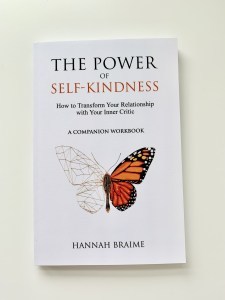
The workbook edition contains all the text of the original book, plus additional questions and space to write your reflections as you work through the book.
The workbook is available in two formats:
Paperback: available through Amazon or to order through your local bookstorePrintable PDF/Digital workbook: available herePlease note, with the digital version, you won’t receive a physical product. The fillable PDF can be used in your PDF reader or with a tablet and stylus.
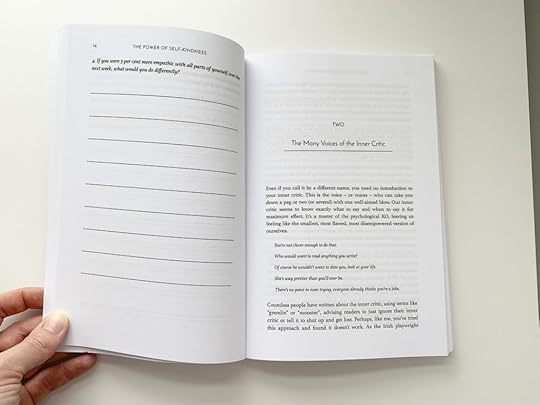 Large print
Large print
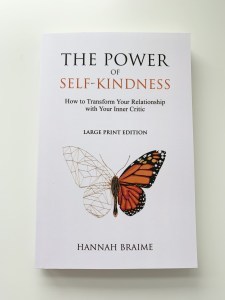
The large print edition is for readers who have additional visual needs (for example, visual impairment or dyslexia). The book has been reformatted with features like larger font, bigger margins, central alignment, bold instead of italics for emphasis, cream pages, and other features that are designed to make the reading experience easier.
The large print edition is available to order through your local bookstore or online here.
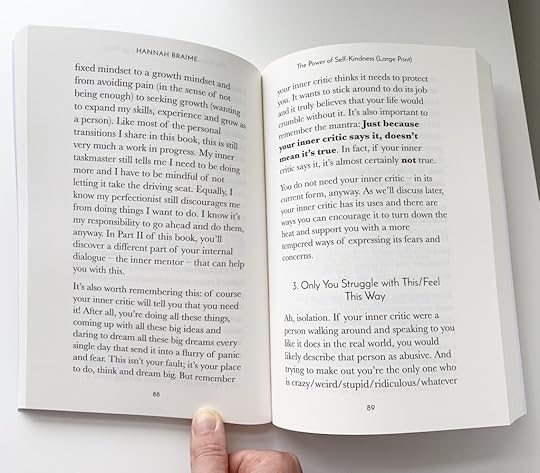 About the book
About the bookEven if you call it by a different name, you need no introduction to your inner critic.
This is the voice – or voices – who can take you down a peg or two (or several) with one well-aimed blow. Our inner critics seems to know exactly what to say and when to say it for maximum effect. It’s a master of the psychological KO, leaving us feeling like the smallest, most flawed, most disempowered version of ourselves.
You’ve tried everything to tame your inner critic: ignoring it, calling names and telling it to shut up. But none of those approaches have worked.
Now, it’s time to stop fighting yourself.
In The Power of Self-Kindness: How to Transform Your Relationship With Your Inner Critic, you’ll discover a radical approach to healing your relationship with your inner critic and yourself, one based on understanding, self-acceptance and self-compassion.
Using a combination of theory, insight and reflective practices, you’ll learn where your critic comes from and how to look beyond its destructive words to uncover the real message underneath. You’ll develop techniques that will help you question your critic’s stories and become more mindful of how these stories impact your life. You’ll also learn how to turn up the volume on the inner critic’s positive counterpart – the inner mentor – a wise inner guiding light invested in your growth and wellbeing.
Whether you’ve been struggling with your inner critic for a long time or are at the beginning of your self-kindness journey, this book offers a range of approaches and suggestions you can use to mend the most important relationship in your life: the one with yourself.
Interested in the workbook or large print editions of From Coping to Thriving: How to Turn Self-Care Into a Way of Life ? Stay tuned as these will be coming soon!
The post The Power of Self-Kindness: Workbook and Large Print Editions Now Available appeared first on Becoming Who You Are.









May 27, 2019
How to Hit the Reset Button on a No-Good Unproductive Day
You know the kinds of days I’m talking about. days we wake up, pour a cup of coffee, and it’s 11am and where did the morning go? days when it’s dark, cold, raining, and we’d much rather huddle under the duvet watching the latest Netflix craze than get up and do our daily creative practice, let alone anything else. days where it feels like we’ve sat staring at our computer screen forever and are making zero progress towards that important thing we needed to do today.
These days happen. We can set up our lives in a way that makes them less likely, but they still happen. Maybe we’re feeling under the weather or didn’t sleep so well, perhaps we’ve over-committed, or maybe we’re just experiencing a little analysis paralysis around all the things we want to do.
Whatever the case, the day isn’t over until it’s over. If you want a do-over, here are a few simple but effective ways we can hit the reset button on a no-good unproductive day:
Cleanse your to- listI used to thrive on to-do lists, but they mean nothing if you’re writing the same old uncompleted items day in, day out. When I’m in a rut, experiencing unproductive day after unproductive day, I know I need to throw everything on that old list out and start again with things that matter.
In his book Getting Things Done, David Allen talks about doing a “core dump.” This involves taking a blank sheet of paper and spending 10 minutes writing everything that’s on your mind right now. This includes things you need to do, things you need to remember, commitments, ideas, things you’d like to try, things you need to pick up from the supermarket—everything. If it’s in your head, get it down.
Then, divide this list into the different areas of your life (I keep it simple, starting with “Work” and “Personal” then creating sub-categories and projects from there). Start with 1-3 most important things on your list; that is your to- list for today.
Create a “to be” listDoing is only part of the equation. And we don’t “do” well unless we’re in the right frame of mind. One way to hit the reset button is to create a “to be” list instead.
What qualities do you want to embody as you live and work today? Perhaps these include:
PatienceTenacityOpen-mindednessLightnessFlowEaseFocusI find it helpful to focus on positive objectives rather than what I want to avoid. For example, “keeping my eyes on my work” instead of “not comparing myself to other people.” Even with “not” in front, the focal point is still the comparison. It’s like if you tell yourself “Today I will not think of a white bear” you’re thinking of the white bear. If you’re having an unproductive day, start focusing on what you do want rather than on what you don’t.
Do that one thing you’ve been putting off/dreadingMost of us have these things: the personal habits we’ve been meaning to start or restart since forever but have yet to do; an email we need to respond to; a looming deadline that seeps into our thoughts at every available opportunity; that favour we said we’d do but never got around to.
Those things take up mental space. They are the piles of old magazines in the corner, the dirty cups and plates left untouched by the sink, the “miscellaneous” pile of old mail and packaging you said you’d sort out later three months ago.
Just as those things all take up space and offer distraction in our physical environment, they do so in our mental house too. Every time we think “I should do X,” that’s time and energy we’re wasting thinking about X without changing anything. We might justify not doing X because we don’t have enough time or have other things we need to do. But we often end up spending more time thinking about X than it would take just to do it.
So just do it. Ride that wild donkey. Get it done. Think of all the mental and emotional space you’ll free up. Think of what else you could spend that time and energy on. It might feel uncomfortable, complicated and difficult but more often than not it’s not as bad as we think it will be. The more you can hit the reset button when you notice the “shoulds” creeping in and just do what you’re thinking about, the easier it will become and the less unproductive days you’ll have. We both know you will feel so much better afterwards.
Take back controlDo you control your day, or does your day control you?
In reality, the answer is always the former, but it’s easy to get caught up in feeling like we’re living the latter. If you feel you’re living at the mercy of your to- list, your commitments or other people’s wishes, it’s time to hit the reset button internally and recognise you’re not.
There is nothing you have to do. Sure, there are undesirable consequences to not doing certain things, but you still have a choice. For everything you’re telling yourself you have to do, stop and switch it to “I want to” or “I choose to.” Does that sit right with you? If yes, why would you want or do these things? If not, why not?
The more you feel like a victim of your circumstances, the less likely you are to change them. When we’re in this place , we feel helpless and out of control so we act like we’re helpless and out of control, which creates a vicious cycle. We end up like a castaway, sitting in a little rowing boat with no paddles, being tossed in whatever direction the waves take us.
No one is dictating your schedule and your commitments but you. Remember: you the captain of your ship. Where will you steer it next?
How do you hit the reset button on a no-good unproductive day? Leave a comment and share your suggestions.
Photo by Sara Farnell on Unsplash
The post How to Hit the Reset Button on a No-Good Unproductive Day appeared first on Becoming Who You Are.









May 13, 2019
Tired of Feeling Creative Envy? Read This.
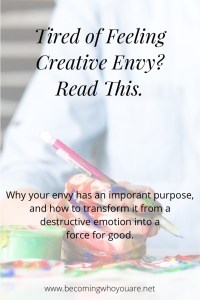
Much of the advice that exists around dealing with envy seems to be along the lines of “just stop it.”
Given that envy is an emotion with an important purpose, however, this isn’t great advice. Nor is it entirely realistic. We can’t pick and choose which emotions we feel, and when we close ourselves off to so-called negative feelings like envy, we also risk closing ourselves off to more positive emotional experiences too. Expecting ourselves never to feel envious is like expecting ourselves never ever to find anyone else remotely attractive just because we’re in a committed relationship.
The feelings will happen at some point. It’s what we do with them that matters.
When we experience envy, it’s usually because it involves something that’s important to us—and this is never truer than with our creative pursuits.
Creative envy happens. It’s what you do with those feelings that matters.
Click To Tweet
Before we go any further, let’s clear up the difference between envy and jealousy. Some people use these words interchangeably, but they have different meanings:
Jealousy is fearing that someone will take something or someone important away from us.
Envy occurs when someone else has something we lack. It’s born from a sense of inferiority and includes a hope that the person might lose what they have in some way.
In other words, jealousy is a triangle: us, the person who is a perceived threat, and the person or thing we don’t want to lose.
Envy only involves two parties: us and the other person. When we feel envious of someone, sometimes it’s because we want what they have. Sometimes, we just don’t want them to have it.
A couple of important things to remember about envy:1. It’s not fair or accurate to compare someone else’s curated outsides to your messy and human insides. We just don’t know what someone else’s day to day looks like or what’s really going on for them (nor does it matter).
2. While we can’t stop ourselves feeling these feelings altogether, we don’t want to buy into the stories behind them.
We might want to justify those feelings by pinpointing all the ways the object of our dis-affection is THE WORST PERSON. Chances are, though, they’re probably not.
Yes, they might carefully curate their public image. Yes they might have a team of ninja support staff doing the not-so-fun helper work behind the scenes. Yes, they might have networked their way straight into Oprah’s chair without producing anything of real substance or originality.
But so what?
They’re not making you any less good enough by doing their thing. You’re doing that by comparing yourself to them.
3. Scratching that envy itch by acting on your feelings is a total waste of energy and time. You can be someone who rises to meet others, or be someone who tries to bring others down to your level.
How to use your envy for goodIn psychology, there’s a concept called “the golden shadow.” This is the idea that positive aspects also lie within the “shadow” side of our personality—we just need to learn how to reintegrate them.
Feeling envious towards someone sucks. It can feel like you’re being ripped apart from the inside.
But.
It can also be a wake-up call.
There’s a reason envy towards one person and not towards another. Usually, it’s because they are reflecting something we’re capable of that we’re not owning in our own lives. Envy is a sign that you are not owning something in yourself. It’s part of you saying “Helloooooo, you are 100% capable of this too.”
When we envy other people, it usually reflects potential we’re not owning in ourselves.Your envy is a signpost. It points you towards needs you’re not meeting (stability, security, comfort, etc.). It also points you towards your own potential.
Your envy highlights the fact that you could totally write a book too, if you were willing to sit with the discomfort of being a beginner. It says you could sell your art as well as well, if you were willing to risk rejection. It points out that you are capable of doing your own version of what this person has done—if you’re willing to put in the work, be consistent, and dare to do it your way.
In summary, envy isn’t the emotional demon we make it out to be. We don’t want to get mired in comparisonitis and we certainly don’t want to waste time and compromise our integrity by becoming nightmare trolls. But envy can point us to the places we’re holding ourselves back, keeping ourselves small, and open up possibilities for a brighter, creatively bolder future.
How do you deal with creative envy? Leave a comment below and share your thoughts.
Photo by Alice Achterhof on Unsplash
The post Tired of Feeling Creative Envy? Read This. appeared first on Becoming Who You Are.









April 29, 2019
10 Inspiring Books to Uplift You During Challenging Times
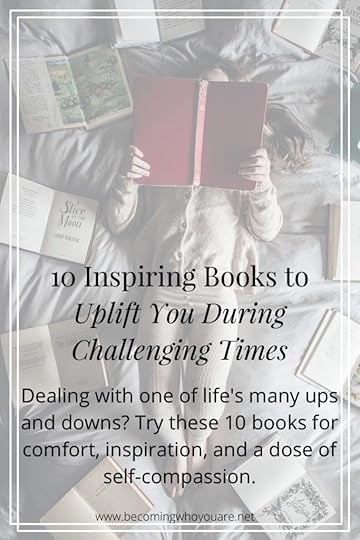
Books have the power to inspire, heal and change lives. They can lift us up, open our eyes to new understanding, spark epiphanies, and lead us down paths we would never have expected. While they are also a font of entertainment, I’ve found books to be one of my biggest sources of comfort during challenging times. With that in mind, this week I want to share 10 reads I’ve found helpful for navigating life’s ups and downs. As you’ll see, the list below contains books of all shapes and sizes, from shorter illustrated books to more meaty philosophical explorations into certain aspects of life. My hope is that wherever you are and whatever you’re facing, there’s something for everyone here :)
N.B. This post contains affiliate links, which means I get a small commission if you use them at no extra cost to you. When you use these links, you help me keep the site going, so thank you!
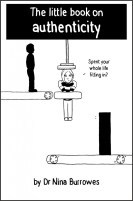 The Little Book on Authenticity is a short and sweet read that dives into the topic of authenticity and what it really means (hint: it’s about more than simply being real). I love this book because it’s technically more of a cartoon/graphic novel, which is unusual for self-help but is a great example of the author, psychologist Nina Burrowes, living the message of the book. It’s also very readable within a single sitting and leaves you with lots of food for thought as you venture back out into the world.
The Little Book on Authenticity is a short and sweet read that dives into the topic of authenticity and what it really means (hint: it’s about more than simply being real). I love this book because it’s technically more of a cartoon/graphic novel, which is unusual for self-help but is a great example of the author, psychologist Nina Burrowes, living the message of the book. It’s also very readable within a single sitting and leaves you with lots of food for thought as you venture back out into the world.
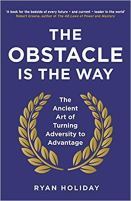 The Obstacle is the Way by Ryan Holiday is based on stoic philosophy and explores how we can cultivate a mindset that helps us build resiliency in the face of hardship. Based on the idea that “what is in the way is the way,” this book is great for reframing challenges and adversity—not through spiritual bypassing, but by accepting that challenges are a fact of life. There are ways we can think about and approach them that will not only help us move forward constructively, but also grow in the process.
The Obstacle is the Way by Ryan Holiday is based on stoic philosophy and explores how we can cultivate a mindset that helps us build resiliency in the face of hardship. Based on the idea that “what is in the way is the way,” this book is great for reframing challenges and adversity—not through spiritual bypassing, but by accepting that challenges are a fact of life. There are ways we can think about and approach them that will not only help us move forward constructively, but also grow in the process.
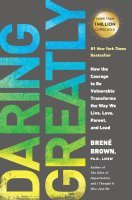 Brené Brown probably needs no introduction, but this is the first of two of her books I’m including on this list because they are perfect for challenging times. I’m a big believer in the idea that role models and mentors don’t have to be people we know personally, and that who we surround ourselves with influence our internal dialogue. Brené Brown is definitely someone I want in mine! Daring Greatly is all about marrying vulnerability and courage in order to step up and do challenging things in life that come with risk but also the potential for great reward. It’s ideal if you need a firm but compassionate pep talk before you do the hard thing.
Brené Brown probably needs no introduction, but this is the first of two of her books I’m including on this list because they are perfect for challenging times. I’m a big believer in the idea that role models and mentors don’t have to be people we know personally, and that who we surround ourselves with influence our internal dialogue. Brené Brown is definitely someone I want in mine! Daring Greatly is all about marrying vulnerability and courage in order to step up and do challenging things in life that come with risk but also the potential for great reward. It’s ideal if you need a firm but compassionate pep talk before you do the hard thing.
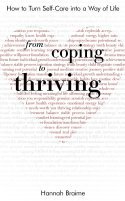 {Shameless plug alert!} I’m including my book, From Coping to Thriving: How to Turn Self-Care Into a Way of Life in this post, because the times when life is most challenging are also the times when we most need self-care that really works. This book is all about changing the way you think about self-care, transforming it from being about something based on superficial feel-good activities, to being about meeting your most important needs. Not always easy, but it will drastically improve your quality of life.
{Shameless plug alert!} I’m including my book, From Coping to Thriving: How to Turn Self-Care Into a Way of Life in this post, because the times when life is most challenging are also the times when we most need self-care that really works. This book is all about changing the way you think about self-care, transforming it from being about something based on superficial feel-good activities, to being about meeting your most important needs. Not always easy, but it will drastically improve your quality of life.
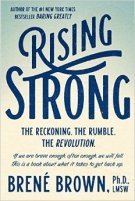 Rising Strong is a follow-up of sorts to Daring Greatly that answers the question: if you dare greatly and get knocked down, what then? This book is all about how to get back up and try again, living as Brené Brown puts it, “whole-heartedly.” Like all of her books, it’s a combination of research and anecdotal examples that focus on vulnerability, courage, shame and how these experiences shape our lives.
Rising Strong is a follow-up of sorts to Daring Greatly that answers the question: if you dare greatly and get knocked down, what then? This book is all about how to get back up and try again, living as Brené Brown puts it, “whole-heartedly.” Like all of her books, it’s a combination of research and anecdotal examples that focus on vulnerability, courage, shame and how these experiences shape our lives.
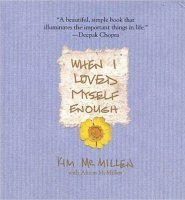 This is the perfect book for when you need a quick pick-me-up or dose of inspiration. More like a poem than a non-fiction book, each page starts with the words “When I loved myself enough…” and continues with a nugget of wisdom that will almost certainly make you reflect on your own life and self-acceptance. It’s like a series of permission slips saying “Here, it’s OK to be kind to yourself,” and I still take inspiration from it years after first reading it.
This is the perfect book for when you need a quick pick-me-up or dose of inspiration. More like a poem than a non-fiction book, each page starts with the words “When I loved myself enough…” and continues with a nugget of wisdom that will almost certainly make you reflect on your own life and self-acceptance. It’s like a series of permission slips saying “Here, it’s OK to be kind to yourself,” and I still take inspiration from it years after first reading it.
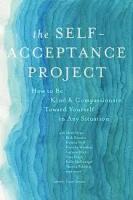 The Self-Acceptance Project is a compilation of essays from teachers and leaders in the fields of philosophy, psychology, and self-compassion. With contributors like Tara Brach, Kristin Neff, Rick Hanson and Jay Earley, the book covers a range of topics related to self-kindness and offers perspectives across the spectrum, from spirituality to hard science.
The Self-Acceptance Project is a compilation of essays from teachers and leaders in the fields of philosophy, psychology, and self-compassion. With contributors like Tara Brach, Kristin Neff, Rick Hanson and Jay Earley, the book covers a range of topics related to self-kindness and offers perspectives across the spectrum, from spirituality to hard science.
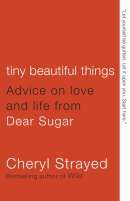 A selection of essays from her advice column for The Rumpus, Tiny Beautiful Things is a collection of responses to questions about common human experiences and complex life issues. Cheryl Strayed’s candour about her own life, as well as her no-nonsense advice to others always leaves me feeling like my problems are surmountable and figure out-able, no matter how intractable they might seem in the moment.
A selection of essays from her advice column for The Rumpus, Tiny Beautiful Things is a collection of responses to questions about common human experiences and complex life issues. Cheryl Strayed’s candour about her own life, as well as her no-nonsense advice to others always leaves me feeling like my problems are surmountable and figure out-able, no matter how intractable they might seem in the moment.
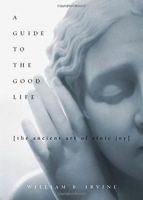 Like The Obstacle is the Way, A Guide to the Good Life is an overview of stoic philosophy that is a great introduction to some of the key principles and ideas on, as the title suggests, how to live a “good life.” In the context of this book, that means moving through modern maladies like chronic dissatisfaction, trying to control things we can’t, and adopting values that leave us feeling disconnected from ourselves and lacking self-worth, towards greater inner peace, self-responsibility, and a life fully-lived.
Like The Obstacle is the Way, A Guide to the Good Life is an overview of stoic philosophy that is a great introduction to some of the key principles and ideas on, as the title suggests, how to live a “good life.” In the context of this book, that means moving through modern maladies like chronic dissatisfaction, trying to control things we can’t, and adopting values that leave us feeling disconnected from ourselves and lacking self-worth, towards greater inner peace, self-responsibility, and a life fully-lived.
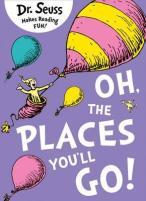 Yes, this is a children’s book! But it’s also so much more. While my daughter loves this book for the rhythm, the rhyme and the (admittedly slightly trippy) pictures, I love reading it with her because it’s a hero’s journey-esque story that contains so many valuable reminders for adult life too. Oh, the Places You’ll Go! is perfect to read when you need a quick reminder that life comes with natural ebbs and flows, or when you’re looking for inspiration and courage as you embark on a change, transition or new chapter.
Yes, this is a children’s book! But it’s also so much more. While my daughter loves this book for the rhythm, the rhyme and the (admittedly slightly trippy) pictures, I love reading it with her because it’s a hero’s journey-esque story that contains so many valuable reminders for adult life too. Oh, the Places You’ll Go! is perfect to read when you need a quick reminder that life comes with natural ebbs and flows, or when you’re looking for inspiration and courage as you embark on a change, transition or new chapter.
What books have you found most helpful during challenging times? Leave a comment and share your suggestions!
Photo by Annie Spratt on Unsplash
The post 10 Inspiring Books to Uplift You During Challenging Times appeared first on Becoming Who You Are.









April 15, 2019
How to Avoid the Curse of Analysis Paralysis
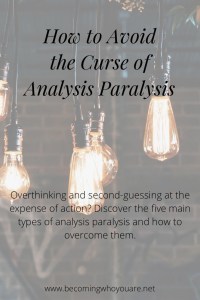
A couple of months ago, I felt stuck. Stuck stuck. I had my list of goals and intentions for this year. I had opened the hood to check they were the real deal: they focused on things I could control, the process , and they were rooted in pursuing growth.
But I also had no idea which one to start with first. I dabbled here, dabbled there, but didn’t make much tangible progress in either direction. As soon as I thought I’d made a decision to hunker down and commit to one thing, I would start to second-guess myself. I switched to working on another goal, second-guessed again, and flip-flopped back and forth, all the while not getting anywhere.
I was experiencing analysis paralysis.
Analysis paralysis (or AP) describes a state where we over-analyse a decision so much that we think ourselves away from action.
Some of us get it over the really big life decisions: where to live, whether to get married or what career we want. If you’re like me, perhaps those decisions feel fairly clear-cut but you experience it with mundane choices: do I get the cat t-shirt or the pug t-shirt? (Obviously, “both” is the correct answer in that situation). What should I have for lunch? What should I read next? What colour font should use in that image?
Although the former kind of AP might seem more important than the latter, they are both a waste of time and energy—and, with that, a growth opportunity.
Analysis paralysis is only a symptom, not the problem itself.
Click To Tweet
Experiencing AP isn’t pleasant, but it is a great opportunity to learn more about ourselves. I’ve noticed the different flavours of AP fall into five general categories:
Decision fatiguePerfectionismFear of being wrongFear of changeThe “Finding your calling” mythDecision FatigueEvery time we make a decision, we use willpower. The more decisions we make in a day, the harder it becomes until we have no decision juice left (side note: this is why a lot of people do their most creative work first thing in the morning or late at night after they’ve had a break). We can also experience decision fatigue if something is sapping a lot of our emotional energy.
If decision fatigue is the source of your AP, look at where you can minimise the number of decisions you’re making in your life. This is why I plan my week ahead in advance, eat the same thing for breakfast, have pretty much the same daily routine and usually throw on pretty much the same thing each morning (a glamorous combo of leggings or jeans, t-shirt and sweater) when I get up. When I do these things, I have way less decisions to make about stuff that isn’t so important to me, which leaves me way more energy to make decisions about stuff that is.
PerfectionismPerfectionism comes in two forms: fear of being wrong (more on that below) and the “single starburst” mentality. This is the idea that we only get one shot at something (a conversation, a launch, a showcase, a pitch) so it has to be 100% right first time around. Talk about pressure!
In reality, there are very few things in life we only get one chance to try.
So what is this fear really about? Taking risks, being vulnerable, and being willing to be a beginner. We can deal with perfectionism by remembering two things: first of all, consistent, dedicated action beats perfection every single time. Secondly, the golden twin of perfectionism is mastery, and the only thing that brings us closer to mastery is being willing to try, practice, and try again.
Fear of being wrongOne of the areas in which I often experience most analysis paralysis is spending money. Should I spend money on X or Y? I kind of want X, but Y is slightly cheaper. OK, I’ll go for Y. But maybe X would be better after all? It has better reviews and seems to be better quality so maybe it will last for longer. Eh…
These internal discussions aren’t unhelpful: I want to have them when I’m making a big purchase like a new computer. It’s when they happen over things like “Should I get the £2.99 sushi or the £3.49 sushi? Or is sushi just a frivolous waste of money anyway?!” that they become a problem
In these situations, the paralysis isn’t around the surface issue, it’s around the fear of being wrong and, on a more existential level, what we think it means about us if we are wrong.
We can move past our fear of being wrong by acknowledging that the difference between making the “right” decision and the “wrong” decision is rarely as clear-cut as we think it is. It’s also useful to dig a little deeper and question the meaning we attach to being wrong. Does buying sushi really make me frivolous or bad with money? Does this decision or that decision really make us a bad person? Flighty? Reckless? Or any of the other things that little voice is saying we’ll be?
Once we’ve done that, we can start to view the times we are wrong as learning curves and opportunities to course correct next time.
Fear of changeAny change rocks the boat and comes with potential drawbacks. Even situations that most of us would welcome without hesitation, like winning $1 million in the lottery, come with significant negatives: you suddenly have the additional responsibility of managing a lot of money, people might have ill-conceived expectations of your newfound millionaire status, it might change dynamics in existing relationships, and so on.
When we give ourselves space to acknowledge the potential negatives and drawbacks of making a decision, we stop unconsciously trying to avoid them and give ourselves a chance to make peace with them.
The “Finding your calling” mythThere is a lot of New Age-y BS pressure around “finding your calling.” Much of this can leave us feeling freaked out about finding the one “thing” that is “our thing.”
This is a quick path to paralysis: If we think we have a single purpose in this world, we don’t necessarily want to take action and discover the “thing” we thought was “our thing” isn’t actually “our thing” after all. Because if not, then what? What if, after 10 years of wanting to be a writer and feeling sure that’s my thing, I sit down, start on chapter one, and discover that I totally hate it?
We can overcome this by recognising the difference between our mission (which is usually fairly abstract) and the vehicle for that mission (which is usually more vocational/practical). My mission in life—which might be very similar to your own—is to be the best version of myself that I can be and to leave my corner of the world better off than I found it. Right now, Becoming Who You Are is my vehicle for that mission. It’s not my one true pre-defined purpose, I don’t know if it’s something I’ll do forever, it’s just one of many possible ways I could create a sense of purpose in my life right now.
Forget the idea that there’s one thing you’ve been put on this earth to do and, as Joseph Campbell says, “follow your bliss,” get on the track that has been waiting for you, get out and meet people also on that track and see what happens. In other words, take action (i.e. live) and recognise that how you live will change and evolve as you do.
When do you experience analysis paralysis and how do you overcome it? Leave a comment and let me know.
Photo by Patrick Tomasso on Unsplash
The post How to Avoid the Curse of Analysis Paralysis appeared first on Becoming Who You Are.









April 1, 2019
How to Create Authentic Connection in Work and Life
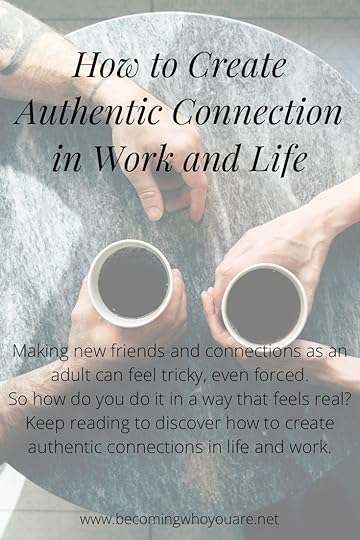
This is a guest post by Eli Trier.
How will you follow up with people and maintain your relationships?For me, it’s all about Instagram DMs and email, with the occasional video chat thrown in for good measure (especially if you’re at the beginning of a relationship with someone). I set reminders in to reconnect with the people on the edge of my circle, but mostly I just reach out whenever someone pops into my head.
How did you meet your favourite people?Think back to where you met your biz besties. Was it on Instagram? At an event you both attended? An introduction from a mutual friend? A mastermind group you were both in? A random email out of the blue? See if you can spot any patterns and if you recreate those circumstances to find more kindred spirits.
or on Instagram @elitriercommunities.
Photo by Joshua Ness on Unsplash
The post How to Create Authentic Connection in Work and Life appeared first on Becoming Who You Are.









March 18, 2019
How to Take Your Journaling Practice Deeper (& Free Video Class!)
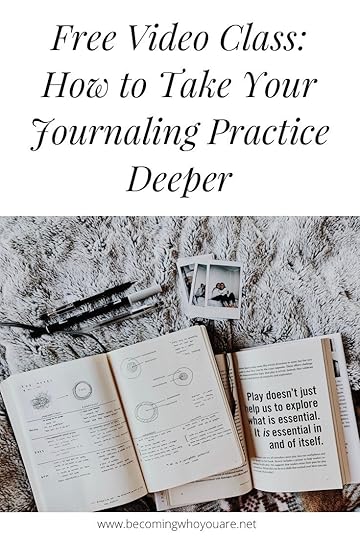 </
</If you’ve been journaling regularly and want to add a few new techniques to your toolbox that will take your journaling deeper, today I want to share a few ideas you can use to do just that. A couple of these suggestions are from my book, The Ultimate Guide to Journaling, which I recommend checking out for dozens of different journaling techniques and prompts you can use to enrich your writing.
Want more suggestion for taking your journaling practice deeper? Check out the full video class and the accompanying written notes in the Becoming Who You Are Library. You’ll also get access to free workbooks, audios, and video classes on personal growth, self-awareness and living a meaningful life.

 Products from Amazon.com
Products from Amazon.com 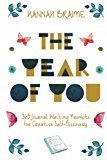 The Year of You: 365 Journal Writing Prompts for Creative Self-Discovery Price:
The Year of You: 365 Journal Writing Prompts for Creative Self-Discovery Price: 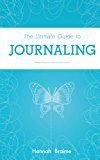 The Ultimate Guide to Journaling Price:
The Ultimate Guide to Journaling Price: Photo by Noémi Macavei-Katócz on Unsplash
The post How to Take Your Journaling Practice Deeper (& Free Video Class!) appeared first on Becoming Who You Are.









February 3, 2019
How to Stop the Cycle of “Compare and Despair”
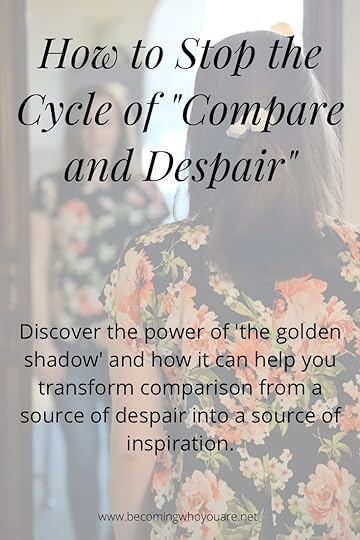
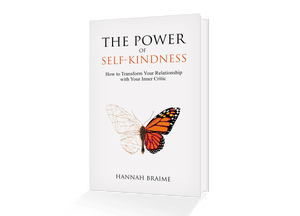 This post is adapted from my new book ‘
The Power of Self-Kindness: How to Transform Your Relationship With Your Inner Critic
,’ which is out now in ebook, paperback and audiobook. To find out more and start healing your relationship with your inner critic and yourself, click here.
This post is adapted from my new book ‘
The Power of Self-Kindness: How to Transform Your Relationship With Your Inner Critic
,’ which is out now in ebook, paperback and audiobook. To find out more and start healing your relationship with your inner critic and yourself, click here.
Otherwise, keep reading to discover how to shift “compare and despair” into “compare and rise up.”
When I first became interested in personal growth, I went to a seminar hosted by a woman who was a self-proclaimed “life coach to the stars”. Several women in the group were talking about comparing themselves to other people, and each time one of them talked about their experiences, the life coach would interrupt, saying, “You just need to stop it, you need to stop comparing yourself to other people.” Someone would start sharing a personal story or situation and she would jump in, saying “Uh huh huh, that’s you comparing yourself to other people. You need to stop that.”
“So . . . how do we stop?” I asked.
“You just do. You just stop,” she repeated for the umpteenth time, now sounding somewhat irritated. I left wondering if there was something I was missing. Comparison was plaguing my life at this time. I wanted to stop with all my heart and soul, so why couldn’t I? Especially when this expert (and she is by no means alone in communicating this message) was saying it was that simple: I just needed to stop.
This question stayed with me for the next few years until I heard a coach called Tanya Geisler talk about the golden shadow. Up to this point, I’d been taking a “compare-and-despair” approach. I’d compare then despair, not only because I’d judge myself against other people and find myself lacking, but also because I thought I shouldn’t be comparing myself to others in the first place; bad Hannah! (There’s that spiral of self-recrimination again.)
What Tanya explained was that comparison – like the inner critic – isn’t something to be feared and avoided, nor is it something to stifle. Approached from a place of acceptance, comparison is a goldmine of insight and awareness about ourselves. We might put other people on a pedestal and feel we come up lacking in comparison.
But if we dig down and specify where exactly we’re comparing ourselves and what qualities we perceive ourselves as lacking compared to them, we have found our golden shadow: the feelings, traits or qualities that we want to embody more in our own lives. When we compare ourselves to other people, the particular aspects we focus on as part of that comparison are a signpost to unfulfilled potential in our own lives. We are capable of being these things too, it’s just at some point we have disowned these traits within ourselves and adopted a different identity instead.
This perspective has transformed the way I approach comparison. Rather than being something I chastise myself for and try to push down, it’s now something I approach with acceptance and curiosity. That’s not to say I don’t still compare and despair at times. I see a friend, a colleague or a public figure sharing photos of their life, describing a recent success or sharing a pithy wisdom bomb. And although I feel happy for them, there can still be a tinge of something bittersweet underneath that, a sense of inadequacy. Because my kitchen doesn’t look that good, I definitely can’t do handstand splits – let alone on a windy rock next to the ocean – I don’t have a New York Times bestseller (yet), and I rarely feel as confident, sorted and creative as other people often seem to be. But when I dig down and specify where I’m comparing myself and what qualities I perceive myself as lacking compared to them, I’ve found my golden shadow. Those aspects I’m focusing on are a signpost to unfulfilled potential in my own life, unfulfilled needs and disowned selves.
Of course, comparison can also be based on outdated beliefs about how I should be living that I no longer agree with, and it’s important to be able to tell the difference. For me, this appears as a difference in how the comparison feels physically. Potential-related comparison feels like sparks, a sense of longing, a desire for growth. Outdated comparison feels heavy, weighted and more like it’s dragging me down than lifting me up.
Want to explore where comparison shows up for you and the role it plays in your life? You’ll find a list of questions you can use to explore this in more depth in the book. Find out more and get your copy here.
Photo by Taylor Smith on Unsplash
The post How to Stop the Cycle of “Compare and Despair” appeared first on Becoming Who You Are.









January 22, 2019
The Power of Self-Kindness: Audiobook Version Now Available!
The Power of Self-Kindness: How to Transform Your Relationship with Your Inner Critic is now available in audiobook through Amazon/Audible. If you have an Audible subscription, you can get the book with one of your monthly credits. Otherwise, it’s also available to download “a la carte” so you can listen on the go.
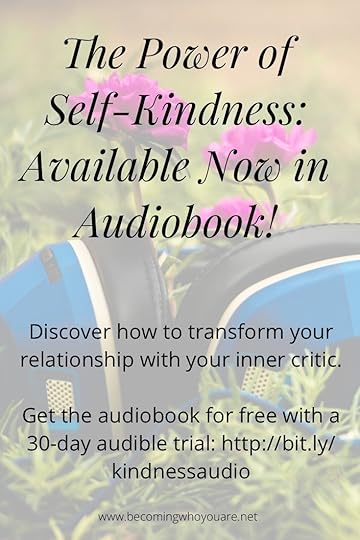
The audiobook is narrated by the ever-talented Stephanie Murphy, who also narrated the audiobooks for From Coping to Thriving: How to Turn Self-Care Into a Way of Life and The Ultimate Guide to Journaling. If you’re a long-time reader/listener, you might also remember her from the intro to the Becoming Who You Are podcast.
Want to listen to the book for free? Get The Power of Self-Kindness: How to Transform Your Relationship With Your Inner Critic with a no-obligation 30-day Audible trial here.
Listen to a sample from the audiobook here:
http://www.becomingwhoyouare.net/wp-content/uploads/2019/01/The-Power-of-Self-Kindness-00-Audible-Sample.mp3Photo by Sai Kiran Anagani on Unsplash
The post The Power of Self-Kindness: Audiobook Version Now Available! appeared first on Becoming Who You Are.











